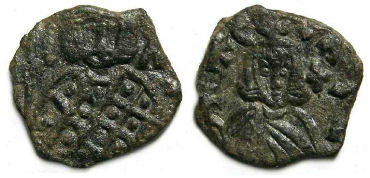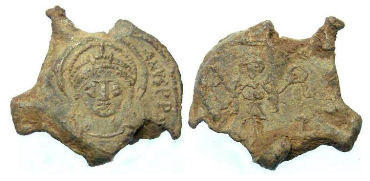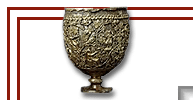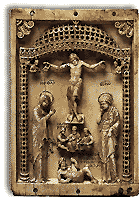
Byzantine. Justin II. AD 565 to 578.
Gold solidus.
Denomination: Gold Solidus.
Mint: Constantinople, 2nd officina.
Reference: Sear-345
Size: 21.3 x 21.7 mm. Weight: 4.46
grams.
Grade: gVF, but with a few scratches
in the upper right of the reverse. On a very broad flan,
very well centered.
Obverse: Helmeted facing bust of Justin
II, holding a globe on which stands a small figure of Victory,
with h DN IVSTINVS P P AVI
around.
Reverse: Constantinopolis seated forward
with head right, holding a spear and globus crusiger, with VICTORIA AVGGG B round, with CONOB below.
SOLD
Order
# 4572
|

Byzantine. Maurice Tiberius. AD 582 - 602.
Bronze
decanummium. Antioch.
Denomination: Bronze Decanummium.
Mint: Antioch (Theopolis).
Date: year-4, AD 585 to 586. The date is
written iiii but
the leading I is much smaller than the others, and appears like it
might have been added later to convert a year 3 die into a year 4
die.
Normally a year 4 would be written with the four I's in two lines,
rather than one.
Size: 16.7 x 17.7 mm. Weight: 2.28
grams.
Reference: Sear-536 variety.
Grade: VF with a very dark brown
patination. Very well struck and significantly nicer in the
hand than the image suggests.
Obverse: Facing bust of Maurice Tiberius with a
corrupted inscription that reads something like D P I C P
I AV around.
Reverse: A large denomination mark X
with a small cross above, flanked by the date mark ANNO (year) and the Roman numeral IIII, with the mint
mark that looks slightly like an R below (that mint mark is only weakly struck
point on this coin
SOLD
Order
# 4095
|

Leo V (the Armenian) and Constantine,
AD 813 to 820. AE follis.
Denomination: Bronze follis.
Mint: Syracuse.
Reference: Sear-1637.
Size: 16.9 x 19.1 mm. Weight: 2.45
grams.
Grade: aVF, dark green patination (almost
black in some light).
Obverse: Upper body of Leo V facing, wearing a crown
and loros, and holding a cross, with L
to the right.
Reverse: Constantine wearing a crown and Chlamys,
holding a globus crusier, with KONST
around, but starting at 10 o'clock, and ending at 9 o'clock (once you
know where to look, you can read the entire inscription).
SOLD
Order
# 3533
|

Byzantine.
Justinian I, AD 527 to 565.
Lead seal impression.
Period: Byzantine, time of Justinian I, AD
527 to 565.
Material: Lead.
Size: 19.2 mm across the rounded part of
the seal, not including the projecting points.
Weight: 7.69 grams.
Obverse: The obverse shows a nimbate
facing
portrait of Justinian, with an inscription naming him (only part of the
inscription is visible). The basic style is similar to that seen on
many of his coin, although he is only shown nimbate on some of his gold
medallions, and on many of this early coins during his joint reign with
Justin I.
Reverse: Victory standing forward with
head right,
holding a wreath in each hand. This design is very similar to that seen
on gold tremessis coins issued from about a century and half prior to
Justinian, right up his time.
There are several unusual features to this seal:
1) The hole
through which the cord this seal fits over is 10 mm wide, which is very
unusual for Byzantine seals of this period (it is usually just a small
round hole no more than 1 or 2 mm wide. This suggest the seal was
meant
to go over a wide cord or ribbon of some type, something more
substantial than a simple document tie.
2) This is a royal seal, with both the image and name of the Emperor.
3) The reverse is very similar to a type of coin that must have
circulated fairly commonly in that period.
4) In spite of being a Royal seal, this is a relatively common type as
early medieval seals go.
No
one knows the how these seals were actually used, I have speculated a
one possible use for this type was to officially seal bags of bronzes
coins, with a total value of 1 tremissis contained in a bag.
The theory that earlier bronze coins were circulated in
that manor,
is a fairly widely held, but as yet un-proven. But is would explain why
this type is relatively common, and why the design is very similar to a
gold tremissis.
PLEASE NOTE THAT THE WHITE COATINGS ON EARLY
LEAD SEALS ARE
LEAD OXIDE, WHICH IS VERY TOXIC IF INGESTED. THESE SEALS MUST BE
HANDLED WITH CARE, AND ONE SHOULD NEVER LET CHILDREN HANDLE THEM (THIS
IS TRUE FOR ANY ANCIENT OR MEDIEVAL LEAD OBJECT).
SOLD
Order
# 3289
|








